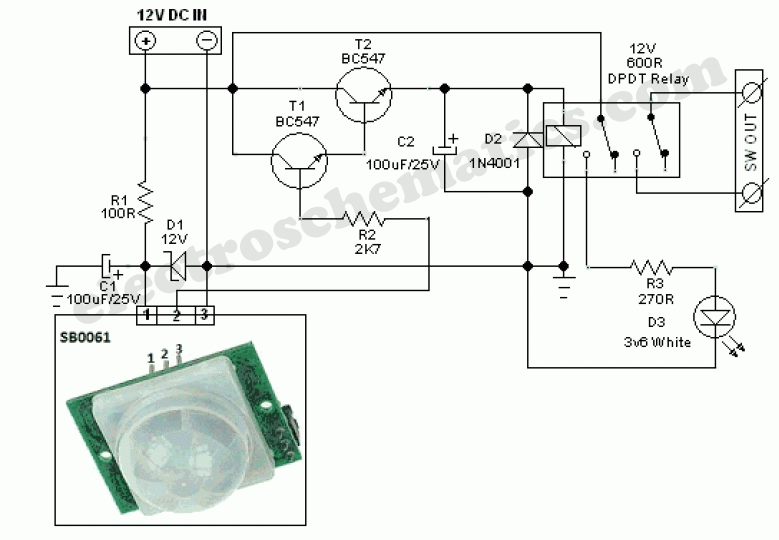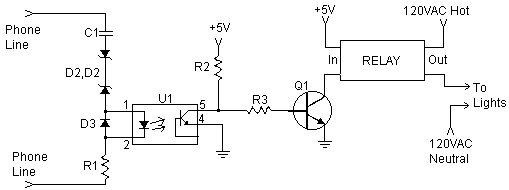
PIR LED Security Light Circuit

This circuit represents a general-purpose white LED security light equipped with a Passive Infrared (PIR) motion sensing mechanism. The core component of the circuit is the PIR sensor module SB0061, which is a pyroelectric sensor designed for human body detection. The SB0061 module integrates a PIR detector with a Fresnel lens on a compact PCB, alongside an analog IC and a limited number of additional components. It outputs a high level (3.3V) signal of variable width. In this security light configuration, the 3.3V output from the SB0061 is utilized to activate six 5mm white straw hat LEDs through a solid-state switch implemented using transistors T1 and T2. The PIR sensor module typically features a 3-pin connection: Vcc (+), Output, and Ground (-). It is advisable to refer to the manufacturer's datasheet to verify the pin configuration, as it may differ. Additionally, the PIR sensor module includes a 3-pin jumper selection for either single or continuous trigger output modes, with positions labeled H and L. In the H position, the output remains high when the sensor is re-triggered, while in the L position, the output alternates between high and low states with each trigger. Consequently, continuous motion in this mode results in repeated high/low pulses. The PIR LED security light can be powered by a compact 9V rechargeable battery; however, the battery charger circuit is not included in the schematic, and any compatible external 9V battery charger may be used for recharging. The PIR sensor requires an initial stabilization period of approximately 10 to 60 seconds to function effectively. During this warm-up phase, the sensor acclimates to the environment, and any motion within its detection range should be minimized. Users of this circuit should anticipate random triggering during the initial startup period.
The circuit design of the PIR LED security light integrates several critical components to ensure optimal functionality. The PIR sensor module SB0061 serves as the primary detection unit, utilizing its pyroelectric properties to identify changes in infrared radiation, which typically indicates the presence of a human body. The integration of a Fresnel lens enhances the sensor's field of view, allowing it to cover a larger area.
The 3.3V output from the PIR sensor is connected to the base of the transistors T1 and T2, which function as a solid-state switch. When the PIR sensor detects motion, it sends a high signal to the transistors, turning them on and allowing current to flow through the six white LEDs. The use of transistors in this configuration not only provides efficient switching but also allows for the control of higher current loads, such as multiple LEDs, without overloading the PIR sensor.
The choice of using a 9V rechargeable battery as the power source provides portability and ease of use, making the circuit suitable for various applications, including outdoor security lighting. The absence of a built-in battery charger in the schematic emphasizes the need for users to select an appropriate external charger, ensuring compatibility with the battery specifications.
The jumper settings for single or continuous trigger output modes allow for customizable operation based on the user's requirements. This flexibility is particularly beneficial in different environmental conditions or applications where the frequency of detection may vary.
Overall, this circuit exemplifies a simple yet effective solution for motion-activated lighting, combining essential components in a compact design to achieve reliable performance in security applications. Proper installation, along with consideration for the initial warm-up period, will enhance the effectiveness of the system in detecting motion and illuminating the area accordingly.Here is one simple circuit of a general-purpose white LED security light with Passive Infrared (PIR) Motion sensing mechanism. At the heart of the circuit is a PIR sensor module SB0061. SB0061 is a pyroelectric sensor module which developed for human body detection. A PIR detector combined with a fresnel lens are mounted on a compact size PCB toge ther with an analog IC, SB0061, and limited components to form the module. High level (3. 3V) output of variable width is provided. In this security light circuit, High level (3. 3V) output from SB0061 is used to switch on six 5mm white straw hat LEDs through a solid-state switch realized using transistors T1 & T2. PIR sensor modules usually have a 3-pin connection: Vcc (+), Output, and Ground (-). The pinout may vary, so it is recommend to check the manufacturer`s datasheet to confirm the pins. Besides PIR sensor module also has a 3-pin jumper selection for single or continuous trigger output mode.
The two positions have labels H and L. When the jumper is at H position, the output remains high when the sensor is re-triggered repeatedly. In position L, the output goes high and low every time the sensor is triggered. So a continuous motion will give repeated high/low pulses in this mode. The PIR LED light security circuit can be powered from a compact 9V rechargeable battery. Note that the battery charger circuit is not included with the circuit schematic. You can use any suitable external 9V battery charger to re-charge the battery pack. The PIR sensor requires an initial stabilization time of about 10 to 60 seconds in order to function properly.
During this time, the sensor gets familiar with the surrounding environment, and any motion in its field of view should be avoided. As stated above, the PIR Module needs a warmup period of about 10 to 60 seconds, during which time it`s adapting to ambient conditions and may trigger randomly.
So anyone using this simple circuit needs to be prepared to accept random triggering for a while after startup. 🔗 External reference
The circuit design of the PIR LED security light integrates several critical components to ensure optimal functionality. The PIR sensor module SB0061 serves as the primary detection unit, utilizing its pyroelectric properties to identify changes in infrared radiation, which typically indicates the presence of a human body. The integration of a Fresnel lens enhances the sensor's field of view, allowing it to cover a larger area.
The 3.3V output from the PIR sensor is connected to the base of the transistors T1 and T2, which function as a solid-state switch. When the PIR sensor detects motion, it sends a high signal to the transistors, turning them on and allowing current to flow through the six white LEDs. The use of transistors in this configuration not only provides efficient switching but also allows for the control of higher current loads, such as multiple LEDs, without overloading the PIR sensor.
The choice of using a 9V rechargeable battery as the power source provides portability and ease of use, making the circuit suitable for various applications, including outdoor security lighting. The absence of a built-in battery charger in the schematic emphasizes the need for users to select an appropriate external charger, ensuring compatibility with the battery specifications.
The jumper settings for single or continuous trigger output modes allow for customizable operation based on the user's requirements. This flexibility is particularly beneficial in different environmental conditions or applications where the frequency of detection may vary.
Overall, this circuit exemplifies a simple yet effective solution for motion-activated lighting, combining essential components in a compact design to achieve reliable performance in security applications. Proper installation, along with consideration for the initial warm-up period, will enhance the effectiveness of the system in detecting motion and illuminating the area accordingly.Here is one simple circuit of a general-purpose white LED security light with Passive Infrared (PIR) Motion sensing mechanism. At the heart of the circuit is a PIR sensor module SB0061. SB0061 is a pyroelectric sensor module which developed for human body detection. A PIR detector combined with a fresnel lens are mounted on a compact size PCB toge ther with an analog IC, SB0061, and limited components to form the module. High level (3. 3V) output of variable width is provided. In this security light circuit, High level (3. 3V) output from SB0061 is used to switch on six 5mm white straw hat LEDs through a solid-state switch realized using transistors T1 & T2. PIR sensor modules usually have a 3-pin connection: Vcc (+), Output, and Ground (-). The pinout may vary, so it is recommend to check the manufacturer`s datasheet to confirm the pins. Besides PIR sensor module also has a 3-pin jumper selection for single or continuous trigger output mode.
The two positions have labels H and L. When the jumper is at H position, the output remains high when the sensor is re-triggered repeatedly. In position L, the output goes high and low every time the sensor is triggered. So a continuous motion will give repeated high/low pulses in this mode. The PIR LED light security circuit can be powered from a compact 9V rechargeable battery. Note that the battery charger circuit is not included with the circuit schematic. You can use any suitable external 9V battery charger to re-charge the battery pack. The PIR sensor requires an initial stabilization time of about 10 to 60 seconds in order to function properly.
During this time, the sensor gets familiar with the surrounding environment, and any motion in its field of view should be avoided. As stated above, the PIR Module needs a warmup period of about 10 to 60 seconds, during which time it`s adapting to ambient conditions and may trigger randomly.
So anyone using this simple circuit needs to be prepared to accept random triggering for a while after startup. 🔗 External reference





